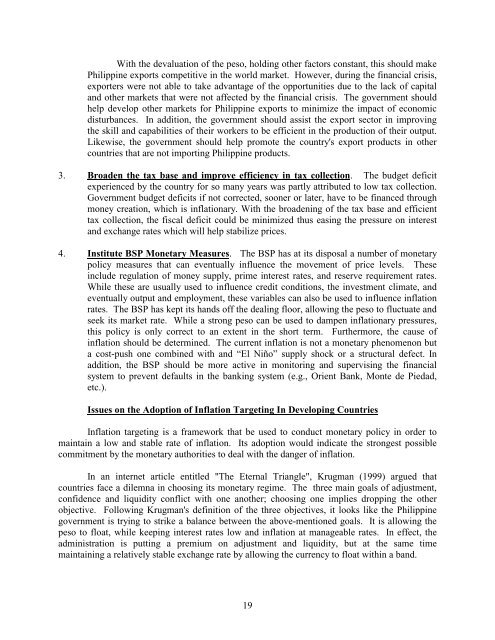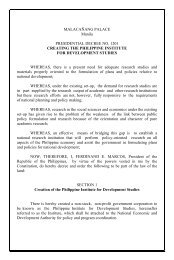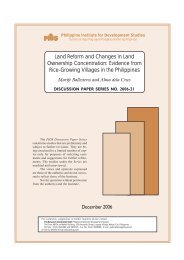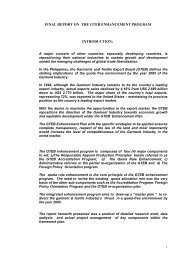price stabilization measures and its effects on - Philippine Institute ...
price stabilization measures and its effects on - Philippine Institute ...
price stabilization measures and its effects on - Philippine Institute ...
You also want an ePaper? Increase the reach of your titles
YUMPU automatically turns print PDFs into web optimized ePapers that Google loves.
With the devaluati<strong>on</strong> of the peso, holding other factors c<strong>on</strong>stant, this should make<strong>Philippine</strong> exports competitive in the world market. However, during the financial crisis,exporters were not able to take advantage of the opportunities due to the lack of capital<str<strong>on</strong>g>and</str<strong>on</strong>g> other markets that were not affected by the financial crisis. The government shouldhelp develop other markets for <strong>Philippine</strong> exports to minimize the impact of ec<strong>on</strong>omicdisturbances. In additi<strong>on</strong>, the government should assist the export sector in improvingthe skill <str<strong>on</strong>g>and</str<strong>on</strong>g> capabilities of their workers to be efficient in the producti<strong>on</strong> of their output.Likewise, the government should help promote the country's export products in othercountries that are not importing <strong>Philippine</strong> products.3. Broaden the tax base <str<strong>on</strong>g>and</str<strong>on</strong>g> improve efficiency in tax collecti<strong>on</strong>. The budget deficitexperienced by the country for so many years was partly attributed to low tax collecti<strong>on</strong>.Government budget defic<str<strong>on</strong>g>its</str<strong>on</strong>g> if not corrected, so<strong>on</strong>er or later, have to be financed throughm<strong>on</strong>ey creati<strong>on</strong>, which is inflati<strong>on</strong>ary. With the broadening of the tax base <str<strong>on</strong>g>and</str<strong>on</strong>g> efficienttax collecti<strong>on</strong>, the fiscal deficit could be minimized thus easing the pressure <strong>on</strong> interest<str<strong>on</strong>g>and</str<strong>on</strong>g> exchange rates which will help stabilize <str<strong>on</strong>g>price</str<strong>on</strong>g>s.4. <strong>Institute</strong> BSP M<strong>on</strong>etary Measures. The BSP has at <str<strong>on</strong>g>its</str<strong>on</strong>g> disposal a number of m<strong>on</strong>etarypolicy <str<strong>on</strong>g>measures</str<strong>on</strong>g> that can eventually influence the movement of <str<strong>on</strong>g>price</str<strong>on</strong>g> levels. Theseinclude regulati<strong>on</strong> of m<strong>on</strong>ey supply, prime interest rates, <str<strong>on</strong>g>and</str<strong>on</strong>g> reserve requirement rates.While these are usually used to influence credit c<strong>on</strong>diti<strong>on</strong>s, the investment climate, <str<strong>on</strong>g>and</str<strong>on</strong>g>eventually output <str<strong>on</strong>g>and</str<strong>on</strong>g> employment, these variables can also be used to influence inflati<strong>on</strong>rates. The BSP has kept <str<strong>on</strong>g>its</str<strong>on</strong>g> h<str<strong>on</strong>g>and</str<strong>on</strong>g>s off the dealing floor, allowing the peso to fluctuate <str<strong>on</strong>g>and</str<strong>on</strong>g>seek <str<strong>on</strong>g>its</str<strong>on</strong>g> market rate. While a str<strong>on</strong>g peso can be used to dampen inflati<strong>on</strong>ary pressures,this policy is <strong>on</strong>ly correct to an extent in the short term. Furthermore, the cause ofinflati<strong>on</strong> should be determined. The current inflati<strong>on</strong> is not a m<strong>on</strong>etary phenomen<strong>on</strong> buta cost-push <strong>on</strong>e combined with <str<strong>on</strong>g>and</str<strong>on</strong>g> “El Niño” supply shock or a structural defect. Inadditi<strong>on</strong>, the BSP should be more active in m<strong>on</strong>itoring <str<strong>on</strong>g>and</str<strong>on</strong>g> supervising the financialsystem to prevent defaults in the banking system (e.g., Orient Bank, M<strong>on</strong>te de Piedad,etc.).Issues <strong>on</strong> the Adopti<strong>on</strong> of Inflati<strong>on</strong> Targeting In Developing CountriesInflati<strong>on</strong> targeting is a framework that be used to c<strong>on</strong>duct m<strong>on</strong>etary policy in order tomaintain a low <str<strong>on</strong>g>and</str<strong>on</strong>g> stable rate of inflati<strong>on</strong>. Its adopti<strong>on</strong> would indicate the str<strong>on</strong>gest possiblecommitment by the m<strong>on</strong>etary authorities to deal with the danger of inflati<strong>on</strong>.In an internet article entitled "The Eternal Triangle", Krugman (1999) argued thatcountries face a dilemna in choosing <str<strong>on</strong>g>its</str<strong>on</strong>g> m<strong>on</strong>etary regime. The three main goals of adjustment,c<strong>on</strong>fidence <str<strong>on</strong>g>and</str<strong>on</strong>g> liquidity c<strong>on</strong>flict with <strong>on</strong>e another; choosing <strong>on</strong>e implies dropping the otherobjective. Following Krugman's definiti<strong>on</strong> of the three objectives, it looks like the <strong>Philippine</strong>government is trying to strike a balance between the above-menti<strong>on</strong>ed goals. It is allowing thepeso to float, while keeping interest rates low <str<strong>on</strong>g>and</str<strong>on</strong>g> inflati<strong>on</strong> at manageable rates. In effect, theadministrati<strong>on</strong> is putting a premium <strong>on</strong> adjustment <str<strong>on</strong>g>and</str<strong>on</strong>g> liquidity, but at the same timemaintaining a relatively stable exchange rate by allowing the currency to float within a b<str<strong>on</strong>g>and</str<strong>on</strong>g>.19









